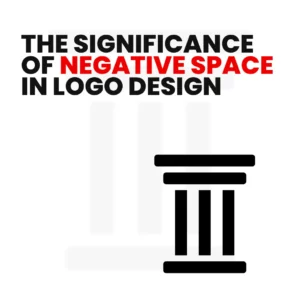Why do you like some logos more than others? Logo design psychology, which is a fascinating field, has the answer. Logos are powerful tools that shape our ideas, affect our feelings, and drive our choices.
In this article, we’ll take a trip into logo design psychology and look at how the clever use of shapes and symbols can significantly affect how you think of a brand. You’ll learn about the psychological factors that come into play when you see a logo and how these parts work together to design a logo that stays with you.
Whether you’re interested in marketing or design or just want to learn more about what makes you like what you like, this article will give you information and insights you can use in your personal and professional life. So, buckle up for this eye-opening look at Logo Design Psychology and prepare to look at logos differently.

What is logo design psychology?
When you see a logo, it is not just a meaningless symbol but a powerful tool meant to make you feel and think in a certain way. Logo design psychology examines how symbols and shapes work together to make an impression on your subconscious mind. You can determine why certain logos make you feel a certain way and how they shape your tastes.
The importance of how people see and think
How your brain processes visual information and makes sense is at the heart of logo design psychology. Your brain is a complicated organ that quickly recognizes patterns, shapes, and symbols and acts on them. This natural ability lets you identify and connect a logo to a brand, making it a vital link in your mind.
The speed with which your brain processes visual information is a big part of how you make first impressions. As soon as you see a logo, you have a first impression of the brand it represents. This first impression can change your feelings about the brand, making you less likely to keep working with it.
Psychological factors that affect how we see logos
Several psychological factors affect how you see a logo:
Familiarity: When you see a logo a lot, you tend to feel more comfortable and accepting. People feel like they know a brand when they see its logo, and this familiarity can lead to trust over time.
Simplicity: Logos that are easy for your brain to understand and remember are simple. A clean, uncluttered design makes it easy to get the message, which makes the logo easier to remember.
Symmetry: Symmetrical Logos look good and give off a sense of balance and security. Your brain is drawn to symmetry, making symmetry designs more appealing.
Cultural and Emotional Associations: Your view of logos can be affected by how you were raised and how you feel about certain things. Some shapes or symbols may have deep meanings in your culture and make you feel things that are important to you personally.
Read Also: 7 Elements of an Effective Business Logo Design
How shapes can make or break a logo
The shapes used in logo design are more than just pretty, but deep psychological meanings. These simple, powerful parts can make you feel something, send a message, and change your thoughts about a brand. By learning about the psychology of shapes in logos, you can better understand how much thought and planning goes into making a solid visual brand.
Circles and curves
Let’s start with soft circles and curves that bring people together. When you see a brand with round shapes, you may feel like you are whole and part of something. The smoothness of curves can make people feel at ease and easy to talk to, which makes the brand look friendly and open. Circle-shaped logos often represent eternity, community, and the idea that everything is linked. Brands that want to make people feel like they belong and trust them usually use the power of rings to make a good and welcoming impression.
Squares and rectangles
The shape of a square or rectangle is a sign of security, order, professionalism, and reliability. Logos with these shapes make people think the company is reliable and trustworthy, especially for finance, technology, and building businesses. Squares and circles that are all the same can also make people feel confident in the brand’s abilities.
Triangles
When you see a brand with triangles, it usually means that the company is strong, powerful, and ambitious. Triangles are lively and energetic, making them suitable for brands that want to show that they are strong and determined. In some situations, triangles that point up can mean growth and success, while triangles that point down can mean stability and a strong base. Brands that want to show their determination and ambition use triangles to grab people’s attention.
Lines and arrows
Straight lines and arrows in logos make you think of progress. They stand for the idea of getting better and moving forward. Logos with arrows represent growth, new ideas, and the power to change. Lines and arrows can help brands get their ideas across visually.
What happens when shapes are combined
It is important to remember that the power of shapes grows when they are put together intelligently. How shapes work together in a logo can improve the message it sends. For example, combining circles and triangles can balance softness and power. Curves inside squares can soften the sharp corners and make a brand look steady and friendly. These combinations add depth and layers of meaning to a logo, making it more attractive to a broader audience and giving the brand a more nuanced personality.
Symbolism in logo design
When you look at a logo, do you ever wonder what the marks mean? Symbolism in logo design is a strong language that speaks directly to your subconscious mind, bringing up feelings, memories, and associations. If you know what the symbols in logos mean, you’ll better understand how brands communicate their values, identities, and goals to leave a lasting impact on you.
The significance of symbols
Symbols are powerful images representing vague ideas, concepts, or feelings. People have used symbols to send complicated messages quickly and easily since the beginning. Symbols are essential to logo design because they help create a brand’s visual identity and leave an impression on your mind.
Influences of culture and history in symbolism
What logos mean is based on how they relate to culture and history. Some symbols have deep meanings that change from culture to culture and over time. For example, a dove may stand for peace in many places but can also mean love and purity. In one society, a symbol that means something good might mean something completely different in another.
When designing for a global audience, brands must be aware of cultural sensitivity and avoid accidentally sending the wrong message. Symbols that are good across cultures can make a brand more appealing and help people from different backgrounds feel more united.
Some powerful symbols in famous logos
Animals as Symbols: Many names use animals as symbols, and each animal has its meaning. For example, the Nike Swoosh represents the Greek goddess of success, which looks like a wing. This link sends a message of success, speed, and athleticism, which fits precisely with what the brand stands for.
Geometric Symbols: Stars, circles, and squares are all examples of geometric shapes often used in logos. For example, the Mercedes-Benz logo is a three-pointed star, which shows that the brand is the best at moving people by land, sea, and air.
Symbols from Mythology and Religion: Some logos are based on symbols from mythology or religion. This gives the brand a feeling of history and timeless wisdom. The Starbucks logo is a mermaid with two tails, which comes from sea mythology and makes you think of exploration and excitement.
Symbols from nature: Nature is full of symbols that can be used to send different messages. The Apple logo, an apple with a bite taken out of it, stands for knowledge and original sin. It refers to Sir Isaac Newton’s finding of gravity and the search for knowledge and new ideas.
The strength of emotional connections
One of the most exciting things about symbols in logo design is that they can make you feel something. Symbols can make you feel nostalgic, happy, trusting, or excited. When a logo does an excellent job of making you feel something, it makes a strong connection between you and the brand.
Think about how the Coca-Cola logo has a unique script style and a bright red colour. Combining classic writing with red makes it easy to recognize and makes you feel happy, warm, and at home. Coca-Cola is a brand that people worldwide connect with happiness and celebrations because of these feelings.
Colour psychology in logo design
Have you ever been drawn to a logo because of its colours? In logo design, colour psychology looks at how colours can change your perception of a brand. Colours help you make connections and leave a lasting impact.
How colours affect how we feel
Colours significantly affect your feelings and can make you do many different things. When you see a brand, your brain automatically connects the colours it uses with certain emotions. Knowing how colours make people feel helps brands choose colours that fit their message and target audience.
Red – brave and full of life
Red is a lively colour that makes people think of energy, excitement, and fire. It is often used in brand logos to make people feel like they need to act quickly or feel intense feelings. For example, the famous Coca-Cola logo uses red to get people excited and interested and to draw attention to the company’s goods on store shelves.
Blue – dependable and calm
Blue is often considered reliable and stable because it is a calming colour people can trust. Brand brands often use blue in industries like finance and technology to make people feel confident in their services. For example, the blue in Facebook’s logo makes people feel like they can trust the site.
Green – natural and sustainable
Green has much to do with nature, growth, and making things last. Logos using green often appeal to consumers who care about the environment and brands that stress environmental responsibility. With its big green siren, the Starbucks logo shows the company is committed to ethically sourced coffee and green business practices.
Yellow – happy and carefree
This colour makes people feel happy, optimistic, and fun. Yellow may be used in the names of brands that want to appeal to young, active people. The golden arches at McDonald’s are a well-known example, as the colour fits with the brand’s logo of being happy and family-friendly.
Colour symbolism in different cultures
It is important to know that the meanings of colours can change from one culture to the next. Some colours mean the same thing everywhere, but others have different meanings in different parts of the world. For example, in some Western cultures, white represents purity and weddings, while in some Asian cultures, it means death and grief. Brands that are known around the world need to be aware of these cultural differences to avoid confusion or sending the wrong message.
Selecting colours for different industries and audiences
Logo designers don’t just pick colours randomly; they do it purposefully to make people feel a certain way and connect with their brand. For example, a health and wellness brand might use soft pink colours to calm people, while a tech startup might choose bright, bold colours to show creativity and innovation.
Combine colours for maximum impact
The harmonious mix of colours is an integral part of colour psychology in logo design. Brands often use colour palettes with two or more colours that are put together in a way that helps the general message. Think about how the red, blue, yellow, and green main colours in the Google logo are arranged in a fun way. This combination shows how fun and creative Google is and how many different goods and services it offers.
Read Also: How to Choose the Right Colour Scheme for Your Website
How to use logo design psychology effectively
Using logo design psychology is vital to make a mark that speaks to your audience. By knowing how shapes, symbols, and colours affect how people see things, you can make a logo that makes a lasting impact and helps people connect with your brand meaningfully. Here are eight helpful tips to help you use logo design psychology to build your brand.
1. Know your audience and the business you’re in
Before making a logo, know who you’re trying to reach and what business you’re in. Think about your possible customers, what they like, and what they value. When you know your audience, you can choose shapes, symbols, and colours that match their feelings and goals.
2. Find a good mix of creativity and simplicity
To stand out, your logo needs to be unique and original, but it also needs to be simple. A too-busy or complicated design can confuse your audience and weaken your message. Try to make a simple, clean logo that shows what your brand is about without any extras.
3. Ask for help and feedback from professionals
Logo design is complicated, and hiring a skilled designer can make all the difference. Experienced designers know the finer points of logo design psychology and can create a logo that effectively tells your brand’s identity. Also, feel free to ask for feedback from coworkers, friends, or even possible customers before you finalize your logo.
4. Test and do market research
Before you use your logo on a big scale, you should test it and do market research to see how it affects your target audience. Focus groups or surveys can give you helpful information about how people see your logo and help you find places where it could be better.
5. Choose colours wisely
Choosing the right colours for your logo is very important to make people feel how you want them to. Refer to the rules of colour psychology and consider what different colours mean in different cultures. Try different colour combinations to find the one that fits your brand and crowd the best.
6. Be careful about how you use symbols
Make sure that the symbols you use in your logo match the ideals and message of your brand. Symbols have deep meanings, so choose ones that show what your brand is all about. To prevent misunderstandings, it is essential to remember that symbols mean different things in different cultures.
7. Be consistent with your brand
Branding is all about consistency, and your logo is one of the most important parts. Make sure that your website, packaging, and other marketing tools, as well as your logo, all fit together well. Consistency helps people remember your company and builds trust and loyalty.
8. Align logo redesign with brand evolution
As your business changes, you may need to change your logo. When thinking about making changes, make sure the remake fits with your brand’s growth and future goals. Changes to your logo over time can show growth and new ideas, making your brand more relevant in a changing market.
Final thoughts
Logo design psychology taps into the human mind and affects how you think, feel, and decide what to buy. If you know how a logo makes you feel, you’ll better understand how much thought and planning goes into designing it. As a professional logo designer in Lagos, logo design psychology has the power to change brands and connect with audiences in meaningful ways. By carefully considering shapes, symbols, and colours, I create logos that stand out and connect my clients with their target audience.
Work with me if you want to raise your brand’s profile and make a lasting effect in a crowded market. I’m committed to learning about your brand to create an evergreen logo that captures attention and stands the test of time.




